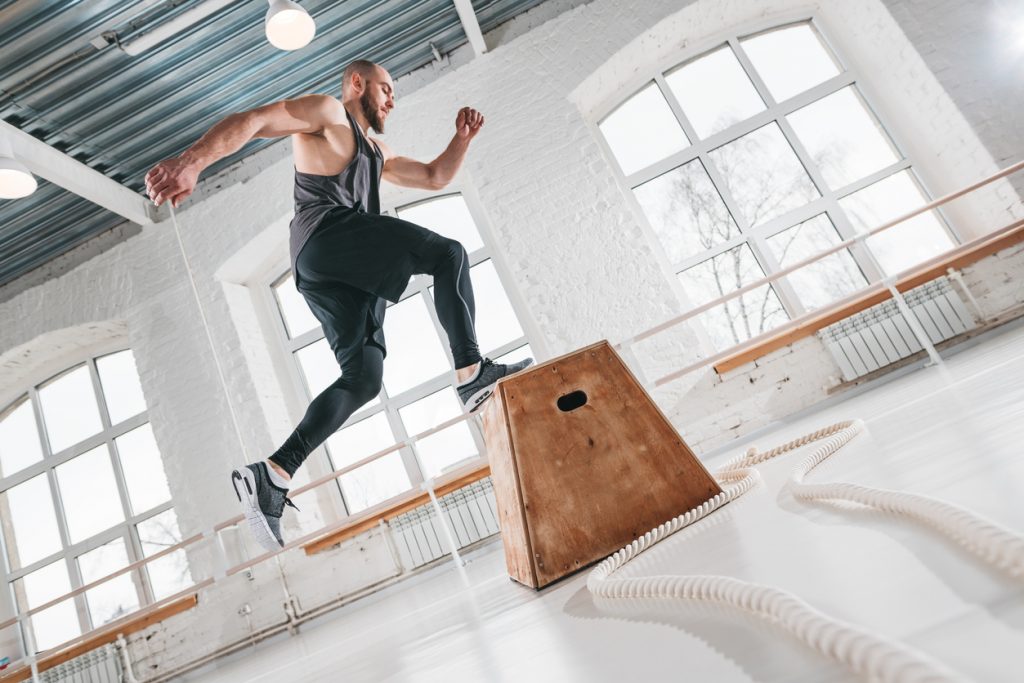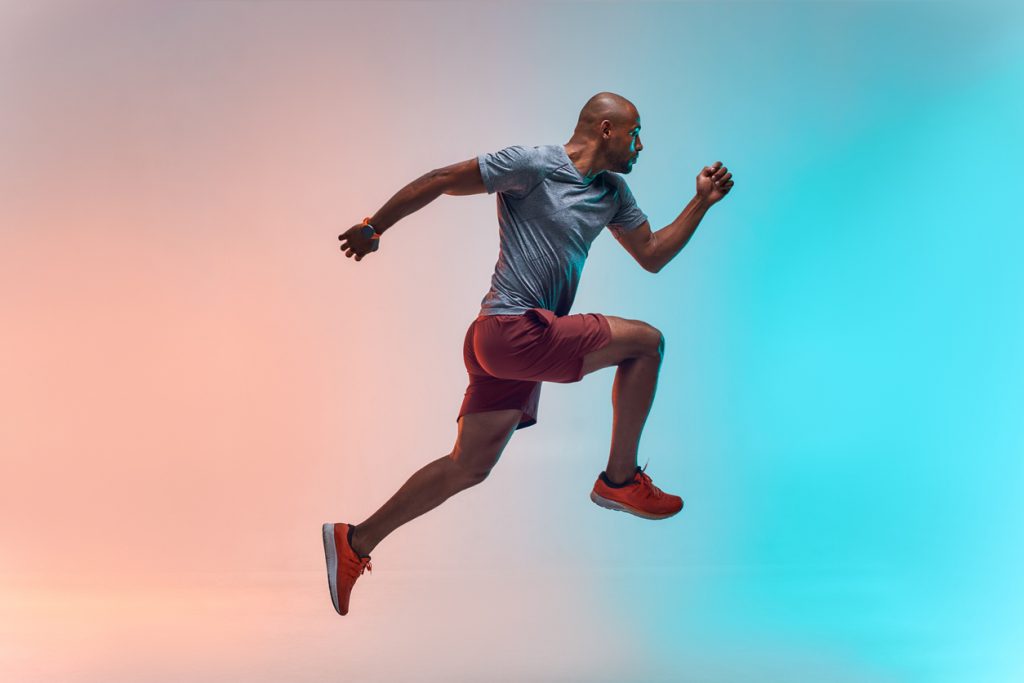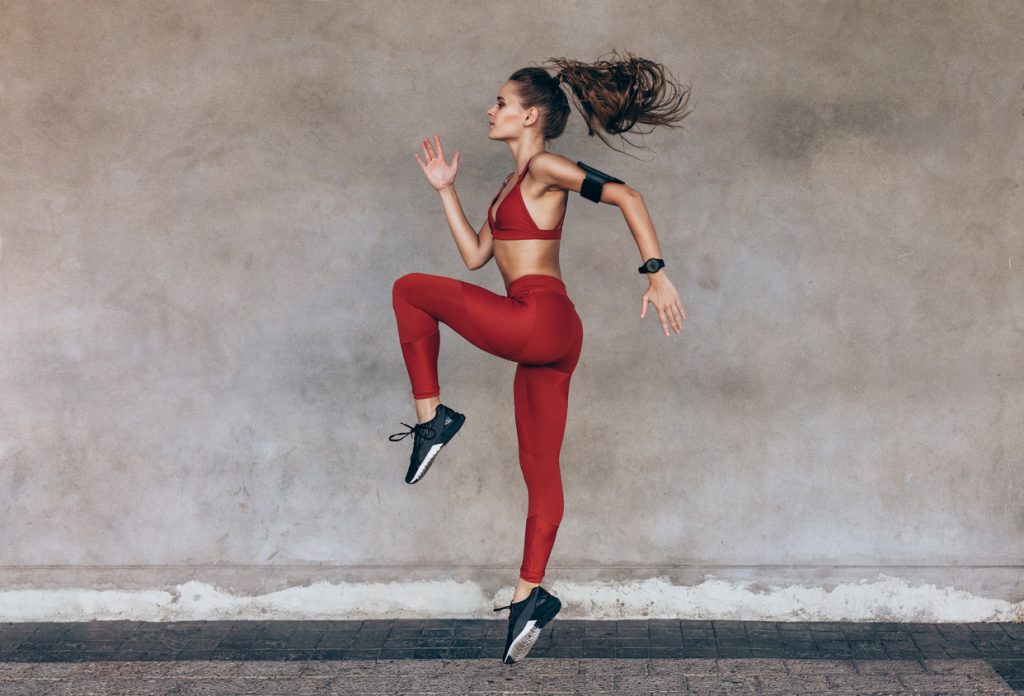In the previous article,we saw that pliometry was based on a complex coupling between the positive dynamic contraction and the negative dynamic contraction of muscle. From the physiological point of view, the factors of the stretch reflex on the one hand and the elastic components of the muscle on the other are involved. The extension-shortening cycle (or stretch-shortening) allows for greater and faster force development through reflex activation.
As mentioned, the most representative exercise of this technique is the depht jump. This exercise, which consists of starting from an elevated platform, taking a step forward, dropping to the ground and rebounding as quickly and as high as possible, has been the subject of numerous studies (1).
During the downward jump, there is a stretch of the quadriceps (extension) on landing and then a rapid contraction (shortening) on vertical relaxation. The important point, for it to be a plyometric contraction, is to ensure that the impact on the ground is very short. In other words, the transition between the landing on the ground and the vertical relaxation should be as short as possible.
Verkhoshansky was certainly one of the first to use downward jumps to improve relaxation skills. His intention was to obtain maximum neuromuscular stimulation, so he used relatively high heights (between 0. 70 and 1. 15m). Of course, the deep jump is not the only plyometric exercise.
THE DIFFERENT FORMS OF PLYOMETRICS
Plyometric training for the lower limbs consists of jumps and various combinations and sequences of jumps.
The different exercises have been divided according to their level of difficulty.
Without load and without accessories and when the obstacles are low, we speak of small plyometrics. For more important obstacles, i. e. more consequent heights and lengths and/or more complex sequences (hurdles, cones, steps, boxes, etc. ), we speak of medium plyometrics and intensive plyometrics with exercises involving respectable heights and requiring already well-developed qualities of relaxation, strength and coordination.
CLASSIFICATION OF THE MAIN PLYOMETRIC EXERCISES FOR THE LOWER LIMBS
- JUMPING JACKS
This involves performing a maximal effort either in height or in length and without taking a run-up. These exercises can be repeated several times in a row in the form of series.
- JUMPS ON THE SPOT.
Performing a jump or series of jumps where the starting and landing points are the same.
This is a jump or series of jumps where the start and landing points are the same.
- MULTIPLE JUMPS
This is a combination of the previous two types of exercises. Various obstacles can be used over distances generally between 10 and 20 metres.
- BOUNCING STRIDES
This is an exaggeration of the various types of strides over distances generally equal to or greater than 30 metres.
This is an exaggeration of the different types of strides over distances generally equal to or greater than 30 metres.
- MULTIPLE JUMPS WITH BOX (PLINTH)
A combination of multiple jumps and deep jumps. This can be combined with exercises involving the length and height of jumps.
- DEPTH JUMPS OR SOMERSAULTS
The weight of the athlete and gravity are used and of course the height of the support which can vary depending on the objective (Strength, Speed, Power).
However, even if the vast majority of references on plyometrics concern exercises mainly for the lower limbs, certainly because the muscular analysis and biomechanics of the shoulder are more complex, the plyometric mode of contraction also concerns the upper limbs.
CLASSIFICATION OF THE MAIN PLYOMETRIC EXERCISES FOR THE UPPER LIMBS
- THE DIFFERENT MEDICINE-BALL THROWS
- DIFFERENT FORMS OF JUMPING PUSH-UPS
Without or with equipment (steps, plinth, medicine ball, floor marks, swiss ball, etc. . . )
- BENCH PRESS EXERCISES
For example, bench presses or inclined presses, either with rebound or with moving the hands on the bar to favour the stretching time at the landing.
- PULLING EXERCISES
For example, in suspension, the athlete performs a light pull-up and then lets himself down quickly to follow up with a full pull-up.
- THE DIFFERENT WEIGHT TRAINING EXERCISES WITH OR WITHOUT MACHINES
Whether it is with dumbbells or with machine, the approach will be the same. The movement is executed on about half or a quarter of the amplitude, then with a spring time the movement is finished in an explosive way.
As for the legs, it is sufficient to precede a dynamic (explosive) contraction by a short stretch and the extension-shortening cycle will thus be respected. Here again the transition phase should be as short as possible.
REMARK
The power required to control the landing of a downward jump depends not only on the height of the jump and the weight of the athlete, but also on the landing mode.
With a cushioned landing, i. e. with a slight bending of the knees at the landing, studies show that the athlete must use a force corresponding to 3 to 4 times his or her body weight. For the same jump with a "locked knees" landing, it will take 6-8 times the athlete's body weight to absorb the impact on the ground.



